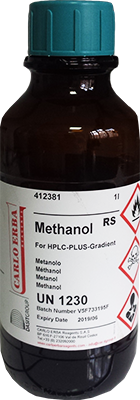The different chemicals
ORGANIC SOLVENTS
Organic solvents are liquids with a composition based on carbon. These can be divided into 9 categories (INRS):
- Aromatic hydrocarbons: benzene, toluene, xylene
- Aliphatic hydrocarbons: hexane, heptane, pentane
- Alcohols: methanol, ethanol, isopropanol
- Ketones: acetone
- Esters: ethyl acetate, ethyl acetoacetate
- Ethers: ethyl ether
- Glycol ethers: 2-butoxiethanol
- Halogenated hydrocarbons: dichloromethane, 1-bromopropane
- Particular solvents: nitrile (acetonitrile), amine (triethylamine)

Acetonitrile

Methanol
The characteristics of organic solvents vary greatly, but some aspects are commonly found among these chemical products:
- High volatility
- Boiling point lower than water
- Flammable
- Toxic
No organic solvent is harmless to health. While only some of them are acutely toxic (short-term), almost all organic solvents can have long-term health effects in cases of frequent exposure.
The only way to control the risk associated with organic solvents is to handle them exclusively under a fume hood wearing adequate personal protection (gloves, laboratory coat and safety glasses), to reduce operator exposure.




